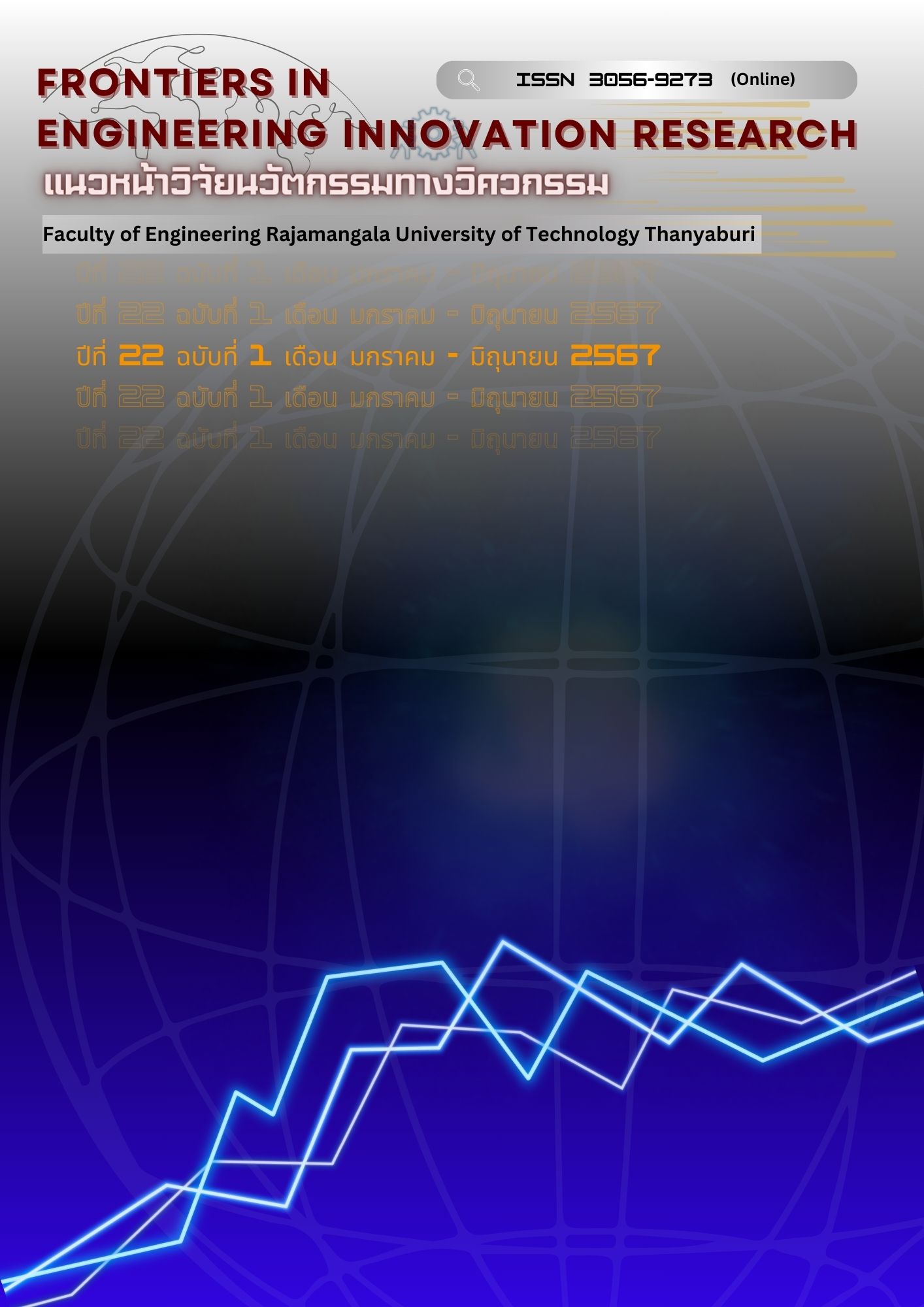การศึกษาคุณสมบัติทางด้านวิศวกรรมและการถ่ายเทความร้อนของคอนกรีตบล็อกผสมขยะพลาสติกพอลิสไตรีน
Main Article Content
บทคัดย่อ
การศึกษาคุณสมบัติทางด้านวิศวกรรมและการถ่ายเทความร้อนของคอนกรีตบล็อกผสมขยะพลาสติก พอลิสไตรีนแทนที่ทรายในอัตราส่วนร้อยละ 0, 5, 10 และ 15 ที่อัตราส่วนผสม ปูนซีเมนต์ : ทราย : หินฝุ่น เท่ากับ 1 : 2 : 6 โดยน้ำหนัก ใช้น้ำในสัดส่วนร้อยละ 10 ของน้ำหนักส่วนผสมทั้งหมด เพื่อศึกษาคุณสมบัติทางวิศวกรรม และการถ่ายเทความร้อนของคอนกรีต ค่าร้อยละการดูดซึมที่อายุ 7 วัน และค่ากำลังต้านทานแรงอัดของคอนกรีตบล็อก ที่อายุการบ่ม 7, 14 และ 28 วัน จากการศึกษาพบว่าอัตราส่วนของขยะพลาสติกพอลิสไตรีนร้อยละ 15 ให้คุณสมบัติทางด้านวิศวกรรมดีที่สุด มีค่าความหนาแน่นเฉลี่ย เท่ากับ 2,258.72 กิโลกรัมต่อลูกบาศก์เมตร ค่าการดูดซึมน้ำเฉลี่ย เท่ากับร้อยละ 6.49 และค่ากำลังต้านทานแรงอัดเฉลี่ยที่อายุการบ่ม 7, 14 และ 28 มีค่าเท่ากับ 50.10, 53.16 และ 53.73 กิโลกรัมต่อตารางเซนติเมตร ตามลำดับ ซึ่งค่าที่ได้เป็นไปตามมาตรฐาน มอก.58-2560 ชนิดไม่รับน้ำหนัก การทดสอบการถ่ายเทความร้อน 60 นาที โดยใช้ไฟสปอตไลท์ให้ความร้อน T1(ฝั่งปล่อยความร้อน) มีอุณหภูมิเริ่มต้น 35 °C เริ่มบันทึกค่า T2 (ฝั่งรับความร้อน) บันทึกค่าอุณภูมิต่างระหว่าง T1-T2 โดยอุณหภูมิอยู่ระหว่าง 35-70 °C ผลการทดสอบค่าการถ่ายเทความร้อนของคอนกรีตบล็อกที่ผสมขยะพลาสติกพอลิสไตรีนร้อยละ 15 มีค่าการนำความร้อน เท่ากับ 3.368 วัตต์ต่อเมตร-เคลวิน ค่าการต้านทานความร้อน เท่ากับ 0.021 ตารางเมตร-เคลวินต่อวัตต์ และค่าสัมประสิทธิ์การถ่ายเทความร้อนของคอนกรีตบล็อก เท่ากับ 48.116 วัตต์ต่อตารางเมตร-เคลวิน การใช้ขยะพลาสติกพอลิสไตรีนแทนที่ทรายร้อยละ 15 ส่งผลให้ค่าการถ่ายเทความร้อนเป็นไปในทางที่ดีอีกทั้งยังเป็นแนวทางในการจัดการนำขยะพลาสติกมาใช้จัดการในการใช้ประโยชน์เป็นวัสดุก่อสร้างที่ต่อยอดได้ในเชิงพาณิชย์ในอนาคต
Article Details

This work is licensed under a Creative Commons Attribution-NonCommercial-NoDerivatives 4.0 International License.
บทความ ข้อมูล เนื้อหา รูปภาพ ฯลฯ ที่ได้รับการตีพิมพ์ในวารสารแนวหน้าวิจัยนวัตกรรมทางวิศวกรรม ถือเป็นลิขสิทธิ์ของวารสารฯ เท่านั้น ไม่อนุญาติให้บุคคลหรือหน่วยงานใดคัดลอกเนื้อหาทั้งหมดหรือส่วนหนึ่งส่วนใดไปเผยแพร่เพื่อกระทำการใด ๆ ที่ไม่ถูกต้องตามหลักจริยธรรม
References
Pollution Control Department. Academic publications Roadmap Plastic Waste Management. Ministry of Natural Resources and Environment. 2021. (in Thai)
Paopongpaiboon K, Boonserm K, Chindaprasirt P, Horsakulthai V. The effect of organic solvent patios on mechanical properties and thermal conductivity of walkway block from waste foam residue. The Engineering Institute of Thailand under H.M. The King’s Patronage. 2019;30(4):121-32. (in Thai)
Thai Industrial Standard (TIS). TIS no. 58-2560 Hollow non-loadbearing concrete masonry units. Ministry of Industry (Thailand), 2017.
Standard Test Method for Sieve Analysis of Fine and Coarse Aggregates. ASTM Standard. West Conshohocken, PA, [Internet]. 2019. Available from: www.astm.org: ASTM International. 2019.
Standard Specification for Flow Table for Use in Tests of Hydraulic Cement. ASTM Standard. West Conshohocken, PA, [Internet]. 2019, Available from: www.astm.org: ASTM International, 2014.
Standard Test Method for Density, Absorption, and Voids in Hardened Concrete. ASTM Standard. West Conshohocken, PA, [Internet]. 2019, Available from: www.astm.org: ASTM International, 2013.
Standard Test Method for Compressive Strength of Hydraulic Cement Mortars Using 2-in. [or 50-mm] Cube Specimens. ASTM Standard. West Conshohocken, PA, [Internet]. 2019. Available from: www.astm.org: ASTM International, 2020.
Aljerf L. Effect of thermal-cured hydraulic cement admixtures on the mechanical properties of concrete. Intercom-International Ceramic Review, 2015;64(8):346-56.
Madhu G, Bhunia H, Bajpai P. K, and Chaudhary V. Mechanical and morphological properties of high-density polyethylene and polylactide blends. Journal of Polymer Engineering, 2014;34(9):813-21.
Wang R, Meyer C. Performance of cement mortar made with recycled high impact polystyrene. Cement and Concrete Composites. 2012;34(9):975–81.
Suwansaard A, Kongpun T, Khemkhao M. Properties of mortar composites from plastic waste. Journal of Applied Science and Engineering. 2021;25(1):59-70.
Suwansaard A, Kongpun T, Khemkhao M. Properties of mortars mixed with polystyrene and hemp fiber wastes. Applied Science and Engineering Progress, 2022;15(1):1-11.
Solomon A, Hemalatha G. Experimental investigation of insulated concrete form (ICF) wall panels under quasi-static cyclic load. International Journal of Engineering and Advanced Technology (IJEAT), 2018;8(2):84-8.
Kaya A, KAR F. Properties of concrete containing waste expanded polystyrene and natural resin. Construction and Building Materials. 2016;15(105):572-8.
Bahij S, Omary S, Feugeas F, Faqiri A. Fresh and hardened properties of concrete containing different forms of plastic waste–A review. Waste Management. 2020;113:157-75.

